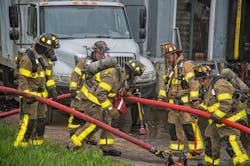The Importance of Kink Management
Every hoseline operation has a target flow rate. The target flow rate is the water flow rate of the fire stream that has been deemed adequate to extinguish the amount of fire that is present. Every aspect of the hoseline operation plays a vital role in ensuring that the target flow rate is achieved and the fire is extinguished, including kink management.
The impact of kinks
Every firefighter, especially those assigned to engine companies, should know that kink management is an important aspect of the hoseline operation, and they should ensure that kink management is performed during every hoseline operation. It is also important for firefighters to understand why they are performing this function. A firefighter is much more effective when they know both what to do as well as why they are doing it and the impact that the task will have on the entire operation.
How much of an impact can a single kink really have on the hoseline operation and the flow rate of the fire stream? The old rule of thumb is that up to 30 percent of the flow rate can be lost due to a single kink in the attack hoseline. While this is a good rule of thumb, it is important that all firefighters perform actual flow tests to determine the exact effect of kinks in the hoselines used by their department. There are many different models of hoselines available and they will all react a little differently to kinks.
Firefighters must understand that any reduction to the flow rate, let alone a 30 percent reduction, can and likely will render the entire operation a failure. This means that the correct hoseline and nozzle can be selected, the hoseline stretch can be estimated correctly, the fire attack team can stretch and advance the hoseline effectively, and upon reaching the fire area, the proper fire attack tactics and techniques can be performed, but the operation can and likely will still fail simply because a kink was allowed to exist in the attack hoseline. Even though the fire attack team may still be able to extinguish the fire after recognizing the problem and assigning a firefighter to remove any kinks in the hoseline, the operation is still a failure because the operation was not performed as effectively and efficiently as it is supposed to be performed. Time was wasted, allowing the fire to cause additional damage.
Firefighters must take the time to know and understand their equipment as well as the capabilities and limitations of that same equipment. It is not enough for a firefighter to simply know that the hoseline/nozzle setup that is being used is capable of producing a fire stream with a flow rate of 150 gpm, 185 gpm or 200 gpm, for example, for a 13/4-inch hoseline. Firefighters must also know and understand the limitations of their hoseline/nozzle setup.
Some of the results were inline with the rule of thumb that a single kink in the hoseline can reduce the flow rate by up to 30 percent. The hoseline with a single kink in it experienced up to approximately 28 percent reduction in the flow rate of the fire stream when the flow rate was reduced from 150 gpm to approximately 110 gpm. The hoseline with two kinks in it experienced up to an approximately 46 percent reduction when the flow rate was reduced from 150 gpm to approximately 80 gpm. The effects of the kinks varied when different models of hoselines were used as well as newer vs. older hoselines.
In sum
The good thing about kinks is that while they are a limitation of a hoseline operation, they are manageable. By ensuring that kink management is assigned to a crewmember during every hoseline operation, kinks can be eliminated. It is inexcusable to allow a kink to reduce the flow rate of the fire stream simply because a kink was not managed and was allowed to remain in the hoseline. Because kinks can have such a drastic negative impact on hoseline operations, it is imperative that kink management is emphasized during every hoseline operation, whether it be during a fire response or during a training evolution. Kink management must be emphasized during training to ensure that it is performed effectively during firefighting operations.
About the Author

Anthony Rowett Jr.
ANTHONY ROWETT Jr. is a captain with the Mobile, AL, Fire Rescue Department. He was previously a firefighter with the Ogdensburg, NJ, Fire Department. Rowett has an associate’s degree in fire science technology from County College of Morris, NJ, a bachelor’s degree in fire science, and a master’s degree in emergency services management. He is a contributing author for multiple fire service publications and has presented at multiple fire service conferences. He has also served as a lead HOT instructor for a hoseline operations class at the Metro Atlanta Fire Fighters Conference. Rowett is the founder of Port City Fire Training. He can be reached at [email protected].


